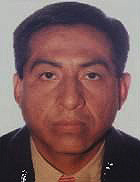|
Néstor Cerpa Cartolini
Néstor Cerpa Cartolini (14 August 1953 – 22 April 1997) was a member, then leader of the Peruvian Túpac Amaru Revolutionary Movement (MRTA). He was sometimes known by the ''nom de guerre'' "Evaristo". He was killed by Peruvian government forces during Operation Chavín de Huántar in 1997. Biography Early years Cerpa was born in the Lima working class district of La Victoria. As a union leader in the 1970s he was involved in the takeover by workers of the Cromotex textile factory in December 1978, which was violently ended by the military government in February 1979, resulting in the deaths of several workers. Following the release of the survivors in late 1979, Cerpa organized a sit-in at the United Nations communications office in Lima. Terrorism In the early 1980s he became involved with the nascent MRTA and quickly rose to be the leader of the San Martín Zone Committee, and thence to the national leadership of the MRTA. As an MRTA militant he is alleged to have led ... [...More Info...] [...Related Items...] OR: [Wikipedia] [Google] [Baidu] |
Lima
Lima ( ; ), founded in 1535 as the Ciudad de los Reyes (, Spanish for "City of Biblical Magi, Kings"), is the capital and largest city of Peru. It is located in the valleys of the Chillón River, Chillón, Rímac River, Rímac and Lurín Rivers, in the desert zone of the central coastal part of the country, overlooking the Pacific Ocean. The city is considered the political, cultural, financial and commercial center of Peru. Due to its geostrategic importance, the Globalization and World Cities Research Network has categorized it as a "beta" tier city. Jurisdictionally, the metropolis extends mainly within the province of Lima and in a smaller portion, to the west, within the Constitutional Province of Callao, where the seaport and the Jorge Chávez Airport are located. Both provinces have regional autonomy since 2002. The 2023 census projection indicates that the city of Lima has an estimated population of 10,092,000 inhabitants, making it the List of cities in the Americas b ... [...More Info...] [...Related Items...] OR: [Wikipedia] [Google] [Baidu] |
Alberto Fujimori
Alberto Kenji Fujimori Fujimori (26 July 1938 – 11 September 2024) was a Peruvian politician, professor, and engineer who served as the 54th president of Peru from 1990 to 2000.* * * * * * * Born in Lima, Fujimori was the country's first president of Japanese descent, and was an agronomist and university rector prior to entering politics. Fujimori emerged as a politician during the midst of the internal conflict in Peru, the Peruvian Lost Decade, and the ensuing violence caused by the far-left guerilla group Shining Path. In office as president, Fujimori implemented a series of military reforms and responded to Shining Path with repressive and lethal force, successfully halting the group's actions. His economic policy and his neoliberal political ideology of Fujimorism rescued Peru's economy and transformed its governance in the midst of its internal conflict. However, his administration was also controversial for alleged abuses of human rights and authoritarian t ... [...More Info...] [...Related Items...] OR: [Wikipedia] [Google] [Baidu] |
Peruvian People Of Italian Descent
Peruvians (''/peruanas'') are the citizens of Peru. What is now Peru has been inhabited for several millennia by cultures such as the Caral before the Spanish conquest in the 16th century. Peruvian population decreased from an estimated 5–9 million in the 1520s to around 600,000 in 1620 mainly because of infectious diseases carried by the Spanish. Spaniards and Africans arrived in large numbers in 1532 under colonial rule, mixing widely with each other and with Native Peruvians. During the Republic, there has been a gradual immigration of European people (especially from Spain and Italy, and to a lesser extent from Germany, France, Croatia, and the British Isles). Chinese and Japanese arrived in large numbers at the end of the 19th century. With 31.2 million inhabitants according to the 2017 Census. Peru is the fourth most populous country in South America. Its demographic growth rate declined from 2.6% to 1.6% between 1950 and 2000, and its population is expected to reach ... [...More Info...] [...Related Items...] OR: [Wikipedia] [Google] [Baidu] |
Internal Conflict In Peru
The internal conflict in Peru is an armed conflict between the Government of Peru and the Maoist guerrilla group Shining Path. The conflict's main phase began on 17 May 1980 and ended in December 2000. From 1982 to 1997 the Túpac Amaru Revolutionary Movement (MRTA) waged its own insurgency as a Marxist–Leninist rival to the Shining Path. As fighting intensified in the 1980s, Peru had one of the worst human rights records in the Western Hemisphere and experienced thousands of forced disappearances while both the Peruvian Armed Forces and Shining Path acted with impunity, sometimes massacring entire villages. 50,000 to 70,000 people were killed, making it the bloodiest war in the country's independent history. This includes many civilians who were deliberately targeted by all factions. The Indigenous peoples were disproportionately targeted, with 75% of those killed speaking Quechua as their native language. Since 2000, the number of deaths has dropped significantly a ... [...More Info...] [...Related Items...] OR: [Wikipedia] [Google] [Baidu] |
1997 Deaths
This is a list of lists of deaths of notable people, organized by year. New deaths articles are added to their respective month (e.g., Deaths in ) and then linked below. 2025 2024 2023 2022 2021 2020 2019 2018 2017 2016 2015 2014 2013 2012 2011 2010 2009 2008 2007 2006 2005 2004 2003 2002 2001 2000 1999 1998 1997 1996 1995 1994 1993 1992 1991 1990 1989 1988 1987 1986 Earlier years ''Deaths in years earlier than this can usually be found in the main articles of the years.'' See also * Lists of deaths by day * Deaths by year (category) {{DEFAULTSORT:deaths by year ... [...More Info...] [...Related Items...] OR: [Wikipedia] [Google] [Baidu] |
1953 Births
Events January * January 6 – The Asian Socialist Conference opens in Rangoon, Burma. * January 12 – Estonian émigrés found a government-in-exile in Oslo. * January 14 ** Marshal Josip Broz Tito is chosen President of Yugoslavia. ** The CIA-sponsored Robertson Panel first meets to discuss the UFO phenomenon. * January 15 ** Georg Dertinger, foreign minister of East Germany, is arrested for spying. ** British security forces in West Germany arrest 7 members of the Naumann Circle, a clandestine Neo-Nazi organization. * January 19 – 71.1% of all television sets in the United States are tuned into '' I Love Lucy'', to watch Lucy give birth to Little Ricky, which is more people than those who tune into Dwight Eisenhower's inauguration the next day. This record is never broken. * January 24 ** Mau Mau Uprising: Rebels in Kenya kill the Ruck family (father, mother, and six-year-old son). ** Leader of East Germany Walter Ulbricht announces that ... [...More Info...] [...Related Items...] OR: [Wikipedia] [Google] [Baidu] |
Caretas
''Caretas'' (, ) is a weekly newsmagazine published in Lima, Peru, renowned for its investigative journalism. History ''Caretas'' was founded in October 1950 by Doris Gibson and Francisco Igartua. In the mid-1950s, Gibson's son, Enrique Zileri, returned from Europe (from where he had been making contributions for the magazine) to join ''Caretas''. Not long after, Igartua departed from the magazine and Zileri joined Gibson as co-director. After several years of monthly publication, ''Caretas'' began to be published semi-monthly, and, since 1979, weekly. A new edition currently appears every Thursday. ''Caretas'' focuses on Peruvian-related topics, ranging from historic coups (it was founded during Odría's regime), corruption scandals, presidential elections, crimes of passion, sports, to wars and terrorism. Since the mid-1980s, ''Caretas'' has imitated ''Time'' magazine by naming a Man of the Year in the year-end issue of the magazine, called ''Premio a la Resistencia ... [...More Info...] [...Related Items...] OR: [Wikipedia] [Google] [Baidu] |
Villa María Del Triunfo
Villa María del Triunfo is a district of the Lima Province in Peru. It is located in the Cono Sur area of the city of Lima. It was officially established as a district on December 28, 1961. The current mayor (''alcalde'') of Villa María del Triunfo is Eloy Chávez Hernández. Geography The district has a total land area of 70.57 km2. Its administrative center is located 158 meters above sea level. Boundaries * North: La Molina * East: Pachacámac * South: Villa El Salvador Villa El Salvador is an urban, largely residential coastal district on the outskirts of Lima, Peru. It borders the district of Chorrillos on the east; the Pacific Ocean on the southwest; Lurín on the southeast; Villa María del Triunfo on the ... and Lurín * West: San Juan de Miraflores Demographics According to a 2002 estimate by the INEI, the district has 329,057 inhabitants and a population density of 4662.8 persons/km2. In 1999, there were 71,889 households in the district. According t ... [...More Info...] [...Related Items...] OR: [Wikipedia] [Google] [Baidu] |
Nueva Esperanza Cemetery
The Virgen de Lourdes Cemetery (), popularly known as Nueva Esperanza, is a popular cemetery located in the district of Villa María del Triunfo, Lima, Peru. It was created in 1961 with the purpose of being used by immigrants from other provinces. It is settled on 60 hectares and contains more than a million tombs. The site is considered a tourist attraction, frequented by two million people each year to cultural activities. It is the largest cemetery in Peru, in addition to being the second in the world behind Wadi-us-Salaam Wadi-us-Salaam (, , ) is an Islamic cemetery, located in the holy city of Najaf, Iraq. It is the largest cemetery in the world. The cemetery covers and contains more than 6 million bodies. It also attracts millions of pilgrims annually. The ceme .... Notable burials * Néstor Cerpa Cartolini See also * Cementerio Presbítero Matías Maestro * El Ángel Cemetery References {{coord, 12, 09, 35, S, 76, 55, 09, W, type:landmark_region:PE, display=title ... [...More Info...] [...Related Items...] OR: [Wikipedia] [Google] [Baidu] |




